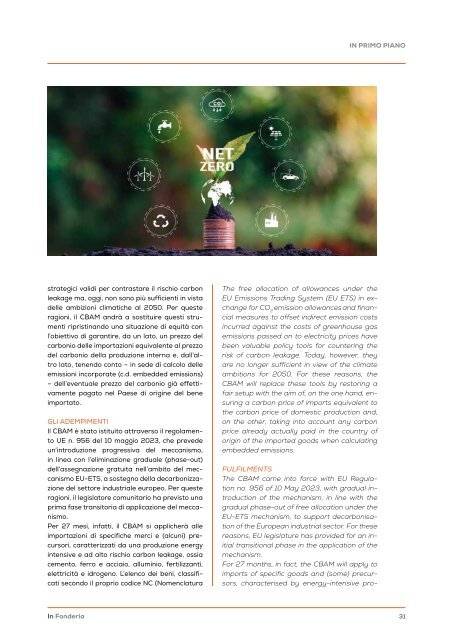In Fonderia 1 2024
Primo numero del 2024 di In Fonderia
Primo numero del 2024 di In Fonderia
You also want an ePaper? Increase the reach of your titles
YUMPU automatically turns print PDFs into web optimized ePapers that Google loves.
IN PRIMO PIANO<br />
strategici validi per contrastare il rischio carbon<br />
leakage ma, oggi, non sono più sufficienti in vista<br />
delle ambizioni climatiche al 2050. Per queste<br />
ragioni, il CBAM andrà a sostituire questi strumenti<br />
ripristinando una situazione di equità con<br />
l’obiettivo di garantire, da un lato, un prezzo del<br />
carbonio delle importazioni equivalente al prezzo<br />
del carbonio della produzione interna e, dall’altro<br />
lato, tenendo conto – in sede di calcolo delle<br />
emissioni incorporate (c.d. embedded emissions)<br />
– dell’eventuale prezzo del carbonio già effettivamente<br />
pagato nel Paese di origine del bene<br />
importato.<br />
GLI ADEMPIMENTI<br />
Il CBAM è stato istituito attraverso il regolamento<br />
UE n. 956 del 10 maggio 2023, che prevede<br />
un’introduzione progressiva del meccanismo,<br />
in linea con l’eliminazione graduale (phase-out)<br />
dell’assegnazione gratuita nell’ambito del meccanismo<br />
EU-ETS, a sostegno della decarbonizzazione<br />
del settore industriale europeo. Per queste<br />
ragioni, il legislatore comunitario ha previsto una<br />
prima fase transitoria di applicazione del meccanismo.<br />
Per 27 mesi, infatti, il CBAM si applicherà alle<br />
importazioni di specifiche merci e (alcuni) precursori,<br />
caratterizzati da una produzione energy<br />
intensive e ad alto rischio carbon leakage, ossia<br />
cemento, ferro e acciaio, alluminio, fertilizzanti,<br />
elettricità e idrogeno. L’elenco dei beni, classificati<br />
secondo il proprio codice NC (Nomenclatura<br />
The free allocation of allowances under the<br />
EU Emissions Trading System (EU ETS) in exchange<br />
for CO 2<br />
emission allowances and financial<br />
measures to offset indirect emission costs<br />
incurred against the costs of greenhouse gas<br />
emissions passed on to electricity prices have<br />
been valuable policy tools for countering the<br />
risk of carbon leakage. Today, however, they<br />
are no longer sufficient in view of the climate<br />
ambitions for 2050. For these reasons, the<br />
CBAM will replace these tools by restoring a<br />
fair setup with the aim of, on the one hand, ensuring<br />
a carbon price of imports equivalent to<br />
the carbon price of domestic production and,<br />
on the other, taking into account any carbon<br />
price already actually paid in the country of<br />
origin of the imported goods when calculating<br />
embedded emissions.<br />
FULFILMENTS<br />
The CBAM came into force with EU Regulation<br />
no. 956 of 10 May 2023, with gradual introduction<br />
of the mechanism, in line with the<br />
gradual phase-out of free allocation under the<br />
EU-ETS mechanism, to support decarbonisation<br />
of the European industrial sector. For these<br />
reasons, EU legislature has provided for an initial<br />
transitional phase in the application of the<br />
mechanism.<br />
For 27 months, in fact, the CBAM will apply to<br />
imports of specific goods and (some) precursors,<br />
characterised by energy-intensive pro-<br />
<strong>In</strong> <strong>Fonderia</strong><br />
31














